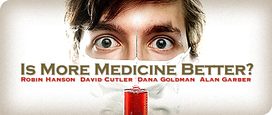Robin Hanson asks David Cutler what is missing from aggregate studies. I can’t help but provide just one example. Suppose some physicians in Region A are better at surgery, while those in Region B do a better job with medical management of heart attacks. And further assume that surgery is more expensive — hardly a stretch. Health outcomes may be very similar across the areas, but costs are higher in Region A because they tend to use more surgery. If we forced physicians in Region A to practice medical management instead of surgery, we might save some money, but we would adversely impact patient health because the doctors in Region A aren’t as good at medically managing patients as those in Region B.
Now, I am not arguing that differential practice styles explains all — or even much — of the geographic variation we see. But this example points out that there is much that we need to understand before we take the scalpel to health care spending. The effort to better assess outcomes is a necessary first step in that direction.
Let me ask the following of Robin Hanson. Suppose we could design a catastrophic health plan, with first dollar coverage exceptions for those therapies that can be shown to be clinically efficacious and reduce total health care spending. (I am thinking of exceptions like free anti-hypertensives which prevent heart disease, but not services like “well-baby” care, which — while very popular with young families — are hardly cost-saving.) Would you be in favor of subsidizing this coverage for the low-income uninsured, with the subsidies paid for by eliminating the tax exclusion for health insurance premiums above the cost of this limited plan?

